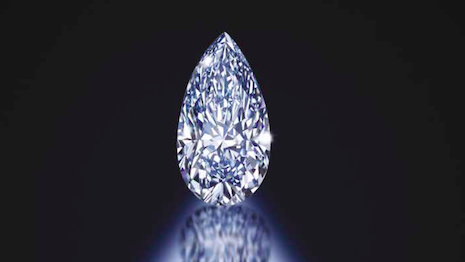While wine held the top spot for wealth investment last quarter, jewelry took a surprising leap, surpassing classic cars as a more valuable method for the wealthy to store their assets, according to new research from Knight Frank.
Knight Frank’s quarterly Luxury Investment Index looks at which categories hold the most value and sway for investment by the wealthy. This quarter saw wine take the top spot as it shot up by 25 percent, followed closely by fine art.
“The Knight Frank Luxury Index provides a fascinating insight into the top areas of collecting," said Bonhams Global Chief Executive Matthew Girling, global chief executive at Bonhams, London, which co-created the report. "People will always seek out the best in class examples in their favorite collecting areas, and our own experience at Bonhams certainly bears out the report’s conclusions with wine, art, watches and jewelry all performing strongly over the past year.”
Jewelry investment
For the luxury consumer, buying expensive goods is about more than just signaling their status, as these goods also serve as an excellent depository of liquid wealth.
Knight Frank regularly examines which categories of products serve this purpose best, and its Q2 2017 report took a deep dive into how this market is shaping up.
What they found was that jewelry had a surprisingly great quarter, shooting up to surpass cars, which have traditionally been one of the top-performing segments for luxury investment.

Knight Frank's Luxury Investment Index. Image credit: Knight Frank
This can be attributed both to jewelry’s record-breaking year in which multiple diamonds and jewels were sold for millions of dollars at auction houses and to cars’ relatively lackluster performance in the past year.
Knight Frank reports that classic cars usually perform extremely well, regularly seeing more than 100 percent growth over the past 10 years, but the last 12 months have seen cars’ performance as wealth investment grow at a measly 2 percent, leaving the field open for jewelry, watches and wine to take over the top spot.
Another contribution to jewelry’s performance is the increasing perception of jewelry as an art form in its own right and not just apparel or adornment.
This can be seen in the rise of artist-created jewelry such as a diamond bangle created by artist Suzanna Belperron which sold for £164,500, or around $221,000 at current exchange rates.
Design or art
As jewelry’s value to the wealthy investor grows, brands and retailers are capitalizing on that desire by making purchasing jewelry easier than ever.
For example, TrueFacet, an online marketplace for pre-owned designer jewelry, launched Brand Boutique, a new platform that will see the company working directly with brand partners to provide new collections and products to customers.
The new shopping experience will debut with 10 brands including Fendi and Les Artisans de Genéve. Brands will gain the benefit of having their products sold through TrueFacet as well as the analytic support from TrueFacet’s insight into consumer behavior and shopping habits (see story).
Jewelry’s relationship to art, and its status as in between art and design, is especially relevant given the growing desire for design pieces over art in investments.

Jewelry's performance. Image credit: Knight Frank
According to research from art and antiques search platform Barnebys, interest in design pieces at auction has grown in the post-recession period, boosted by the added accessibility courtesy of ecommerce.
In 2016, TEFAF valued the market for design items at auction in the United States and Europe at $343.6 million, part of the total $16.9 billion total global public auction market for goods that includes art and jewelry. Fifteen popular designers have seen their turnover grow a collective 330 percent from 2009 to 2016, with some pieces achieving six-figure sale prices that rival fine art (see story).
Part of jewelry’s success is that it exists in between these two categories, equally as valid as a design piece, meant to be worn and used, or as a piece of art that is valuable and desirable to be displayed on its own.
{"ct":"VCItMIOFQRcge5W0BlKGkz8vKwN36wKXZq7+158y\/R6pfhoA8f1QNvOV8cba+UE38Rvo3EHgyOh2AaV7ucQbNsHLKtHH61gxBuquIHqu198bvBdTp3Q06dFNAf5EryoVTGgoSPoD33RPTuJeV\/edwaYCQlS6NHxGAU4w2tBbKGz1Kf4tpbJWsCqdGJ2SXAr\/FygORT3myJIri2mpUdNvpgmyeEX\/u29CKtRWYOluJLGBAXMbRKDSKa5R2zA64v5f721ULENgWQ0v\/YZHPKsqFG9IXj6zyiKoe+WuBoI74HlOy\/8Sk5X0fu\/4X5G7VfoaI+bfdPsEDwmyAqEqd\/IzFSqzcdMsiabSHnj9yhj\/puTrnNXhWpwDVpW3ENnEm48fQ725iIyPIv7uHXLGCD9luDhtNpJc7ivsS3imq9lhowDOIwT\/9e5k5WkJMaxfEJOv20QEWEbjNJAjMiwobijSQvmlhZ6s1pot814\/3fGJh+lHbWpD6ulRmpur0fea6+jnmHGMz8iajaYOlUpAtJC3faTj9yzVLl2gEkWRLQ945sQL\/i5gEOyrP9iENV3b4Xe\/1s9IxJE473CCEAsRAkl9gkANgpC3sPbFPbDkSMdr6LDkTFIZb82YdknTWN96xA08aK1snweVHryZdIQ6dS30ljb1wAR7S9f9pK03x3aft55EGwgU1v\/xT3EEr1Y4DVY\/NurDGG53SKTO0Iex9p2a9n3IlK3o9PgnU3mYV8w67f\/EZn0d+mSb23PxovZMi07cdAfDzVJBU29n+9kdtj6USPzRyPHCi3lhyZqpRkdWip1XFrP1r00KphC++1qiE3SKFcvlaJfNZC08DA47DcH84NVuO7mA7cJW\/GK23SW0pe+ip53QI3J9eQ\/7WMSsWbKz69TCsnvLf3MWDjH0KZZIU5PRejzcay0lcrgTqZtdRmYxLow74eDE9rBJG4rbYV1UZcA0omGILLpe3zx+BATylTwzkLiGHzPPwsRIj1\/\/lbQSNUYZ7gawzCWKu6zmkKsSmPq6V4V4TVFJebZeSx6XItjua2D90Sp3gCg6ToDMIFj7u4YxmXmQDSy7NoWScL2+05e9B0V6s5T3gDNIH5Qnh2WMs1pjajJkjMymXBMydoeJ4Sjk32Vl4LfLBSYKrQr16XrqclCToLMOe3aY9kGPtXZjzhdxTkVcyO+9Lh6UQpUiPWVPeQ7eXmelA2xzaKJvWpIOftbtdzLmK9oJfgLd0JIbfT928ptSC3oCmTC50TUv8g3uPzcfTzSdMEv7hx+YoXUzWk\/B6XGhI+SQNq3sCGcBo0kK+7ciUppvA4fsSb5xrOuY+O0h7\/tGe9NnPmakCjIVO8O4yn0xw5A7CoSWRPWnqHV9X0RUnfJDWWo5OIf4AL3V8qB0oP0CoMUb4D+Q5VWI\/G8z+hIEmcczOSngRg19UhlznCsfY7DDG+nD9Bz38ujp2ljngjz4XzUDPNADnGNlho0fgsXHgcTvTyzgXsijTpMe41c85\/+5eMnyDmknItXqAj4YQ6kpPWcGLgjEhaeto3FqfkBMXHBDjYj8PoI2naJMKxvqTEaknlFSpq3kUzUJKBXeElP1Vli0Uoax21uoyUecAa8A+FPKsieTHJ4he0QbXCoL1YM1h+\/fL9eP+lugNEaa+zNIhZvdsdzlYmwrkuwQGmcrnH3G2BlovB2JY2OOltbqXIE9SQmycFb+cFEiT8iYVSzKDip8W0XjQmgaBmcYwD8u5fQDQ5ERUNZLaDSTJOpnVsYj\/Ipu4ORrb+PG\/VsSQUk8mzZUSdyTaoYC9N2Xl8mO6ovnERpLtMrQGiPdRMY4DyTo8dk+0+HZ\/3sejPCpbWI2AVUGdl5EqMAgeKsXewb1gru\/u6GS5nfNUY8\/lhelMVLVdpkD1s9BqdWmv08BXkF9ufaaJF8Rl7o4+v4mFXWZW08lwxr4NpBxJgiY89B7SylIDvLC1LPy3XlOUt14Vn7O0LQ661ffdf2gn5sQwFOHsvtj44POKesUueUHbDv5E2ucqtqsOJY6HeTTOIY04pZ28i5N4vEcxhUHDnxaeRUVorIcQT1XhBVD9NMoraO3QhB1kc8kW+ZtiJvmK3cc0tfInNV6zwbkveuSN845xvW7FDx+hInNm6SD93alX4PCDBOQ0wLI7uQXvxJGu1ET1xsvCTuNJ7A+iX1gc15og1wWHRpHjZrfZi8dRlWYPAFad1+jMX\/o\/vgVoauvJz06Vcpbg2SNgzI11MW43t420Q3uJf0kkDq8trkgFlsgZUcUBS2Hb6AwYxY0Or3AwTN9vYt8798lA9GA4bDqoEJ7oi9SD681d3pPvxV4sV9Day5f8BupGWNLuNKfQJazxIJD\/A0pXmKtnLLqmo\/NpOWgH+\/Ku\/uz8IEWjF0KF\/tvkc4d1Q0npRdv+rnasP9F8ZDQ3HwMsY4vMEdAMCYEBqlsm55Sv9BnLWA9rH\/v2jkfE4TZzoHSN51bDHLWOG2GEO0S2lTcDdnTWp0GJ+wG5ZCtoSuT\/EXsPifYoM10WeTpV7Xqn7NtIe8OFELJyMw5QmmmUuxJ37Ug+c4Fym025aZKEOWlqFS7wX+GpLcsZhW1NeLk6QJ+EJHhuRuW8wr6rq4r+n4YAL73suC1JHfwt0f3\/aFG3CDOsI81K\/vml9C9g\/KG4i0aAdhIhx4RohucIBSbcMg6Bz1MziwwP7lZDU5+vqi6LwiISv0R\/mSslC9pmPOcjkjojVMWl7ZLJ+DxkBczOEo2D55qMyp+VvqYlh2O23o9BqS\/\/FhrvbLc+RNxPCPlfwqxD+C1fUCSNh373+jghQH6+Bqvapwc2\/Svo018\/TzIYEF\/O98b6SrY2FYYFLuNPjDZd0n4i0\/JZe5ljmyMuVKI6teA0NM3FlzGs6hHJB176Nl4Kw+6rigMHn6PDW2Y1PtdQ+PpEeG92XCRtOkGXCxdR3oQzL7bwlXdFTjkmpJ0OFLfKStzr+CiraUDHU87SXPkrpcI02njGDMJe1CbZ25bTCuC6IR7FCB2\/1FnJE+vuylr\/KH2K0emPeOTnLUm2S\/shpWjEO2imIvwVwVBDoa7V3narejSiePBU3HQsrYvkCIt9HzOzIew6XTzVCwvAFPPIyMeL5I2Ow1hRiizaz775Wr9twj7hsRu4IOVxc4tPa+aXkk4ejztDzB410hXqMFpbbpo8fGBnpwGfKNw0Kz2vidKfepBfboxtDOwAfrLQiuRt7jkGA6SlkwmTNrSsVwAM+BlOfcbLCUK8qtC87bUOI5CtWia0UtFG\/E8vKwz\/XFHkKOPQqhRsTc168j0JfS\/U4kUPqdKSFCsSr\/cRs9XRBNX4q3k+IkeX\/4wupG\/0B4t\/SeZkJEVgeDGKAxVyNvcW1ZLF+cOqA2sfG18x\/WJfkw3\/tELwusY0yi74lEe7POzFH3zbsikIRvX+2ZQmYkfqs6ia41m5K0iREZVGxyKo4VtGQR6\/4mu0u60NeAcElLbHsWWCN82HquL\/ubv4Y4Z+mJe7BbkzNX6MBqzDtTeh9nYhgEw1Q+wmFZnU38fvtuhnmXlZNL\/ozy+rXpgKg64JrQlUCVy90U9M+rK2fIxicoHR0aUn3G3Y1i01XWjMTcHe5mJpqBRyfrAJj4Jf41OYtNTqv3hK6ogXl4V6NtJjAjqKFKr6bJfwrDeYxJJU2TPalAtXsbzdHSrR7\/ag6dcf9UcMsVlBgiJZ4L+aBSjfuI57pTu5dhpvBKTl2e\/X07Q63Si\/ASN9nZkU+K6nyhD6icLxw6HW\/4NOHsCLgm4veO+V5jzpnLVUHiuo2XHpgZK95kAw1RicVMRdrVX5Fw+6TW8QACMEsh1OmOsap+Y5zDQWl8euCBz3bOAyo6Hz+j+rvGNsmceVdD2CmHZ6mNXanHVjzUEAoVdYOFyzZ1mwcGMx4mCAANtCnkw2mzoyP1VCbScaQ972qkCR1\/fH4W3Ix\/d2hlDb1MizzUikn+uGwPn8\/g4T2rjSD+lfs0nZ5mxzRuxNpWMvqcTHGIxd3Z6ZCMzQtZlfFXYrIrk6VUbuo2abCbwyD8nKhdnCAD1hTb4bQvsEjSJQI9i67wRUm8N7fqIQoZSCvBaDpa6GBaIlO1SJiZQy4vdO1BxmAKsyUuTM25+a9NfhkZU8qVMkbZaY5TePY7OSS0FnUyJ0gVcUzP1sjwIygZJWxKzu1MGdx8W3qwmjKwL4dJMp\/m7EbB0xhyN7\/u1bo6zB+2an09VSxF7O918dTJ+\/aGaexAGGVDNrIpsnPzIfet5jKxORNqPYQkkSL5tnZLgKIQssm\/fWUs70hPByaioq5es298EoHLcfW88tVLlsEHpQU2zkaoneLkoCNd6svyrr4KOn2kUy0YCSmonOQzArZexaitCSCLf7hP670MPzUBMIxjPylctt\/AsNSffDL5KMJHmKWGIBhZXYxdGIAACIfNVx4hjEtXQlmA2Bjgiu0L3eZLOLNJX0ha2p0\/tOORIUb8K4gb7XAIE3rWLFELYe0r+JCKGg5lu15xvTWbRi\/AKyDjiWIhA8AUu+r30\/gBVqTPZihPwV6lrKCEVyY7d96XqCY\/7D4Y\/b3bm2rN64+ZSToplqGE4zu9Z3YM75X4Bgsh+gD\/px\/fm7EKV4KGJ0pc9O6BELXAZm6mrGPvY7N0JuAq4fe6KvDCRKTs+LbfcgKhhGDlLaa1Y13HCKw4AwbAwlV8PeABUnCexGNtqukWNb4K9B5E8Arx9QUe13r4QJP62MoXpkQXvEeqCgTVQfi4xK2fUgibzmDYZ3XIohHbxA2QHqySviL4lJ0IFuD\/bPN0dY0N3FA6c1jff92Z1RWtRljFVFVC0dgX5Tc8G674+H5bWlylBepbd6xDYfeHvG9PPRxef4h4PauN4E3NdKZsI2FZMa7ZdCvmmzcoQC4Qmxo\/gJaXW7mV2v7N5dR+CE01XLjdgHRMD3T\/D52A383LlAkj81c2fWu+e+iiMPFC5DxwjakLP+86rNvDF+FXF0ipg9hX6oPFz\/2yYzH4fL7uTPXSdt2nj3R\/hPKUk8AiazEkPiwMFF907bGfC28\/YGGViPFiwNiMNolf8xGaW6wVbDmu2S3Zhkz8GSdzg2jUJ4k7HwOnoGQcEp2MQjHjgUHfFYQ2gLTHBe37zWfCh+sd8Xh3SaHfN0HUCDPDMHmM635E3qbUhx08KeByIKVBtGD3UjZFRQX8pF\/3SEidMCNw6qGj3FEI4jLYxDWkmGDvCigFis5H1DEaRnFF\/KYCC0IHSi3zyzq7bXRWG2Ub71Y\/tSRIIe+uHu24ZjydOaja34\/pnQ8Q6r1tv8sIFv\/EXST3vqO1c0sNJrtCDaDueZNMjeqJihR5i50ryUxQEjvUO06SA7wTxPQzaYzHuge1AbNQtZiAu1AhiA7wb50IpYjZ3NIs6JAPlvqrWtHBRMknDhsMPM1WISy49OAt277H3FULcy13szMS+v5\/OlSjjbOV68R8SiEvjx1\/gKNQ2zDmQeV1jkAfuXN0a0eW\/\/NoWpOCzPWFv6QGKn1S\/TPAZCrZI+YQABeWS\/pY\/FyZCIdxqDlo2Z2eVTPjknlrS4ofouBqkbdHTTswOm76nhsbgx67oV3B1\/1xLEvigR8vFUZ0l\/UUbGMo2aS8lwsP9PxWdgk9l7GVY2EHF2rnluW0Z6QzPFS13Rz0MK+Zj8rlBr\/qlnS6Q3r80e\/+\/SnUOb0BCgeuDXvgtFpo\/DCJt1VuG9Woqu0NIvO3rT3zi4t+7F70tBMfvCkEizXj8DvxCB2fya+r5vRNBvOCzUFJpR2D0T7HBrTw4EU1qw7oR2rpmtXrSTPVU4CvUTafuIkSj7\/eoaztNnLi9GODEuWaezXqUU5SOCwt3JqCO8VXt51qQFOXUetRWdjqNjKI7WzCNqRpGkZLyzI3WoH29GghIJ9cIFxS7+LToF7hTea2u7xGgmdvFkWeM1N1gEhDDueHyst4CQIaT8ezZb1ZeSzaN2fDjYk0itLyd5ONdW2XHpzcqvYzwXSzV24xCQ4v7j1lFUy0ktmmZeqSk2JJHijtgcfcUlvCzi23rrv6ogg4dwIVGnit4aQ4KguGY5+GMH6pa5S64oE814QFvyZ3430qhGhH2XuEfvdfP+F8BxW7FUXrTUQKDn2Ur7OG8Ok0sMwSFqE4XEg5wUQN4K2Jh1dph4BPaqR6LAdkg\/9UQLmwy8+JBESB41iI4+b3X+X7i+uLJm6YAyRLFX8h1rgqOap6dBuHAakGKf70pMPj\/kN04zI\/N75y2C54nWl61uvxsYOMYIrJTOhxcOLyGvJRKz4r1pshxiCAfT8Fi\/Ek69bn47o\/hou3XhfypJOue31k7mmsa0B+T4MpuusfFMIj887Xkzm\/SPKD7oXTV0XDSk1iQJgUUT2f2uWFJguTb1lkL1KoxF+OE2iiSsTEnnS5DzBheER2GhqlieBYRSP8vk5UjVT0HTO9EzGig7qPhkEYLIik7niy8hBe7LugZevCySdcwjkJIo3DqMl\/Bk1GaMyykeL\/uqLPAGAJC1f7G4U9AR6gAjG5YxWtxkjWGK+eo4KPioVzLOoXj+eoFMjyFqchCiQuo+Jo1Z1VUWJVgibGnOfaBrVXVMqP8XfNiK9GZVG5UpQn5Ywqad0JEO\/u52qUaCBA5C2q9uiokhAdZyQvkgX8J7Dm3xtN4TXFkxsRXJ+rZGWS0GNWrJKZSNgOOTY2QUbOVVWW88WDFlDCSLNwZXBvb6A6sRGwt2a5zU6Tp4dMFoZgRP2dJ9EMyN1H7qUCsFdmKcrkoLNLl6IbxuFi+2s8iMUfHrdbxpdrU\/tlL\/wILf3B4r58LkGg96dmWMV3wsrSbnUsX0nnv0sWLNSIvvHQNxMs9Y86bWPooOeQKV\/\/LbwgWIuZMcV1Bnw6NCzArAoHYF8b4KREtu2VnlEscv2kvgIamFl\/NL\/JXr6HVTgMDHhqzaqMU0e\/oMcGv+910Ri+dAnIsNGmaTAXJ3s6KvsisuYXEB1dTZq1VP3hgnkR4vmhR5aIUjw9fIGJ\/\/6l1+HHniTpJiHHPBXRleGG05QfDBRKBI6UL+D8gqTpVx3IRRelPON\/LjHGZWeBAuVHSnOs9BUwlaAAWaPUGp7Q0cN43U23GNnJtFV0F4vizBHxLn3C76vKgYOTbndVyVRNGz3Ys9w5JNClzLjNjlNoHBDygB+chJiz8T4ecf+BaRI96hXoVpi8NtOBt1I9vfVf9kNdt5gUs0EHu85tBfR0JG3SxXL+Lt0q8Sje0IekEufqZEiYUHwBQMwkdPuPaHtVcttodmxhLZuOIEBauc7POAQH5CADF4MJ3Rb3U\/6J68zZ4sV9VIhCs\/3r5oc8yzi2QKSONr1WYTbBAo+l6iW+uHMpTR5gvWVYM8Ua8b+appmwaI0PGmU8ZC+JcdscXseIlV2njM\/OCfiOp6POS7gqEELVQjAjdWvEv8olxgJ4z0OHX5d5lm1zZYZBfmINjO0OXMuFuSfWzDtDhmWoxU7wvl8c=","iv":"234e251833d0476ec48959f05a9df8c1","s":"a9a91b10ef6e0178"}

 Jewelry outperformed cars last quarter as an area of investment. Image credit: Knight Frank
Jewelry outperformed cars last quarter as an area of investment. Image credit: Knight Frank